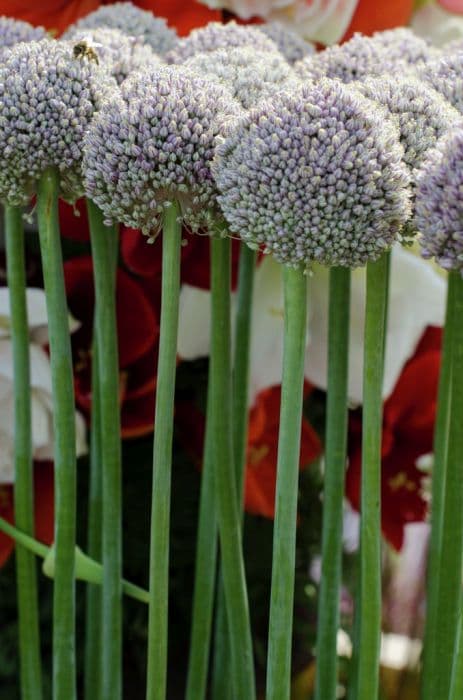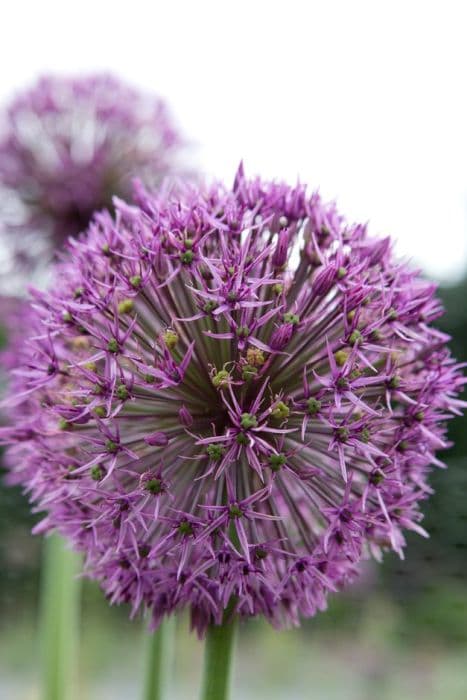Allium 'Hair' Allium vineale 'Hair'

ABOUT
'Hair' is a clump-forming, bulbous perennial, to around 60cm tall, with grass-like, rounde, hollow leaves. In summer, dense flower umbels, up to 4cm across, are borne comprising purple centres from which emerge tendril or hair-like green extensions
About this plant
 Names
NamesFamily
Amaryllidaceae.
Synonyms
Wild Garlic, Crow Garlic, Stag's Garlic, Field Garlic.
Common names
Allium vineale var. compactum, Allium vineale var. kochii, Allium vineale var. vineale.
 Characteristics
CharacteristicsLife cycle
Perennials
Foliage type
Deciduous
Color of leaves
Green
Flower color
Green
Height
2-3 feet (0.6-0.9 meters)
Spread
1 feet (0.3 meters)
Plant type
Bulb
Hardiness zones
5
Native area
Europe
Benefits
 General Benefits
General Benefits- Ornamental Appeal: Allium vineale 'Hair', commonly known as Wild Garlic, adds visual interest to gardens with its unique, hair-like flower blossoms.
- Drought Tolerance: It is resistant to periods of low water availability, making it suitable for xeriscaping and low-maintenance gardens.
- Pest Resistance: Wild Garlic is not typically prone to pest problems, minimizing the need for chemical treatments.
- Deer and Rodent Repellent: The strong scent of Wild Garlic can act as a natural deterrent to deer and rodents, protecting other plants in the vicinity.
- Low Maintenance: Wild Garlic requires minimal care once established, with no need for regular fertilization or pruning.
- Easily Naturalized: It can naturalize in suitable climates, spreading to form drifts that fill in spaces and suppress weeds.
- Soil Improvement: As a member of the Allium family, Wild Garlic can help to improve soil health and structure through its root system.
- Edible Uses: The leaves and bulbs are edible (though care should be taken not to confuse with toxic plants), and can be used to flavor dishes.
- Pollinator Attraction: The blooms of Wild Garlic attract bees, butterflies, and other pollinators, contributing to the overall health of the garden ecosystem.
 Medical Properties
Medical PropertiesThis plant is not used for medical purposes.
 Air-purifying Qualities
Air-purifying QualitiesThis plant is not specifically known for air purifying qualities.
 Other Uses
Other Uses- Allium vineale 'Hair' can be used as a decorative element in bouquets, where the unique curly topsets add texture and visual interest to floral arrangements.
- The fibrous nature of the plant allows it to be used in traditional crafting, such as making twine or rope from the dried stems.
- As a natural insect repellent, gardeners may place wild garlic around other plants to deter pests without the use of chemicals.
- The plant is known to have been used historically to create dyes for textiles, providing a range of colors from its different parts.
- Used in companion planting, wild garlic can help enhance the growth and flavor of certain vegetables and fruits when planted nearby.
- The seeds of Allium vineale 'Hair' can be spread on fields as a natural method to prevent soil erosion due to their robust root system.
- The strong scent of the plant can be harnessed to create natural air fresheners or potpourris, offering a rustic, earthy aroma.
- Some artists and crafters use dried Allium vineale 'Hair' in creating natural sculptures or as part of mixed-media artworks.
- In ecological restorations, wild garlic might be planted to maintain biodiversity and balance within the ecosystem.
- Wild garlic can be used in landscaping for ornamental purposes, adding a wild and natural look to garden designs and naturalised areas.
Interesting Facts
 Feng Shui
Feng ShuiWild Garlic is not used in Feng Shui practice.
 Zodiac Sign Compitability
Zodiac Sign CompitabilityWild Garlic is not used in astrology practice.
 Plant Symbolism
Plant Symbolism- Intrigue: The unique, almost whimsical appearance of the 'Hair' variety, with its wild tufts resembling a hairdo, often denotes uniqueness and whimsy, sparking curiosity and fascination.
- Protection: Alliums in general are often associated with protection as they are thought to ward off evil spirits and bad luck; gardeners sometimes plant them among other crops to deter pests.
- Perseverance and Strength: Alliums, including the 'Hair' variety, are hardy plants that can grow in difficult conditions, symbolizing the ability to endure challenges and remain strong.
- Unity: The globular shape of the allium flowerhead, composed of many small, clustered flowers, can symbolize unity and togetherness, illustrating how many individual parts can come together to make a whole.
 Water
WaterWild garlic needs to be watered moderately, ensuring the soil is moist but not soggy. Typically, it requires watering once a week, but this may vary depending on climate conditions. During the growing season, in spring and summer, increase the frequency of watering to support growth. Approximately 1 inch of water per week, either from rainfall or irrigation, is sufficient. During the dormant season in late fall and winter, reduce watering as the plant has lower water requirements.
 Light
LightWild garlic thrives best in full sun to partial shade. It is adaptable, but planting it in a spot that receives at least 6 hours of sunlight a day will promote healthy growth. However, in particularly hot climates, some afternoon shade can help prevent the leaves from scorching.
 Temperature
TemperatureWild garlic prefers temperatures within the range of 60°F to 75°F for optimal growth. It can tolerate temperatures down to 28°F and survive short periods of frost, but prolonged exposure to temperatures below freezing can damage the plant. It is hardy in USDA zones 4 through 8, enduring the varying climate conditions within these zones.
 Pruning
PruningRegular pruning of wild garlic is not necessary, but removing spent flower stalks after blooming can help maintain a tidy appearance and prevent self-seeding if desired. Pruning can be done in late spring or early summer following the bloom period. Additionally, cut back any yellowing foliage in the fall to keep the plant healthy.
 Cleaning
CleaningAs needed
 Soil
SoilWild garlic 'Hair' thrives best in well-draining soil with a mix that includes perlite or sand to enhance drainage. It prefers a soil pH ranging from 6.0 to 7.0. A balance of potting soil, compost, and grit or perlite is ideal to ensure nutrients and proper aeration.
 Repotting
RepottingWild garlic 'Hair' does not require frequent repotting and can typically be repotted every 2 to 3 years or when it is visibly outgrowing its current container.
 Humidity & Misting
Humidity & MistingWild garlic 'Hair' prefers moderate humidity levels and can usually tolerate the natural humidity found in most outdoor environments.
 Suitable locations
Suitable locationsIndoor
Place in bright, indirect light and ensure moderate humidity.
Outdoor
Plant in full sun to partial shade with good drainage.
Hardiness zone
4-8 USDA
 Life cycle
Life cycleWild onion 'Hair' begins its life cycle as a seed, which germinates in favorable conditions of moisture and temperature, typically in spring or fall. The germinated seed develops into a small bulb, which sends up grass-like leaves and establishes a root system. As the plant matures, it forms a distinctive flower stalk with a globe of small flowers and tufts of green growth that resemble hair, giving it its characteristic appearance, usually in early summer. After pollination, often by insects, the flowers produce seed capsules, and the plant may also propagate vegetatively through bulbils formed in the flower head or offsets from the parent bulb. The aerial parts of the plant die back to the ground after seeding, while the bulb enters a period of dormancy, particularly in areas with cold winters. With the return of favorable conditions, the wild onion 'Hair' resumes growth from the bulb, completing the cycle and starting a new generation.
 Propogation
PropogationPropogation time
Spring-Early Summer
Wild garlic, commonly referred to as Allium vineale 'Hair', is generally propagated through division, which is the most popular and reliable method of propagation for this plant. Division is ideally done in either late summer or early fall, after the foliage has died back, or in the early spring before new growth begins. To propagate by division, carefully lift the clump of wild garlic from the ground using a spade, ensuring that the bulbs are intact. Gently separate the bulbs from the mother plant; each bulb should have some roots attached. Replant the bulbs immediately at a spacing of about 4 inches (10 cm) apart to allow for adequate room for growth, and at a depth of around 2 to 3 inches (5 to 7.5 cm) deep. Water the newly planted bulbs well to help establish them. This simple method ensures a high success rate and will produce new plants that are identical to the parent.









